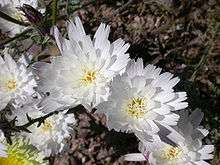Rafinesquia neomexicana
Rafinesquia neomexicana is a species of flowering plant in the family Asteraceae (Commonly called the Sunflower Family[2] or Daisy Family). Common names include desert chicory,[2] plumeseed, or New Mexico plumeseed.[1][3] It has white showy flowers, milky sap, and weak, zigzag stems, that may grow up through other shrubs for support.[2] It is an annual plant (completes its life cycle in a single season) found in dry climate areas of the southwestern deserts of the US and northwestern deserts of Mexico.[2]
| Rafinesquia neomexicana | |
|---|---|
 | |
| Flowering plant near Amboy, California | |
| Scientific classification | |
| Kingdom: | |
| (unranked): | |
| (unranked): | |
| (unranked): | |
| Order: | |
| Family: | |
| Tribe: | |
| Genus: | |
| Species: | R. neomexicana |
| Binomial name | |
| Rafinesquia neomexicana | |
Distribution
In the United States the species occurs in California, Nevada, Utah, Arizona, New Mexico and Texas.[1] It occurs in the Mexican states of Baja California and Sonora.[4]
It is found in the Mojave Desert, and in the Sonoran Deserts including the Colorado Desert sub-region.
It occurs in sandy or gravelly soils in creosote bush scrub and Joshua Tree woodland plant communities in the Mojave Desert and Sonoran Desert, from California to Texas and northern Mexico.[2]
Description
The annual plants are gray-green with sparse foliage and are between 15 and 50 cm high.[3] Basal leaves are 5 to 20 cm long and pinnate with narrow lobes while leaves further up the stem are smaller.[3]
White flowerheads appear at the end of the stems between May and June in the species native range.[3]
Flower heads occur singly at the tip of branches.[2] The flower heads are composed of strap-shaped ray flowers, growing longer toward the outer portion of the head, and collectively creating the appearance of a single flower as in other sunflower family plants.[2] The outer flowers in the head extend well beyond the 1/2" to 1" long phyllaries (bracts enclosing the flower head before opening).[2]
References
- "The PLANTS Database". USDA, NRCS. 2009. Retrieved 2009-08-16.
- Pam Mackay, Mojave Desert Wildflowers, 2nd Edition, p135
- Spellenberg, R. (1979). Field Guide to North American Wildflowers - Western Region. National Audubon Society. ISBN 0 375 40233 0.
- Flora of North America
External links
| Wikimedia Commons has media related to Rafinesquia neomexicana. |